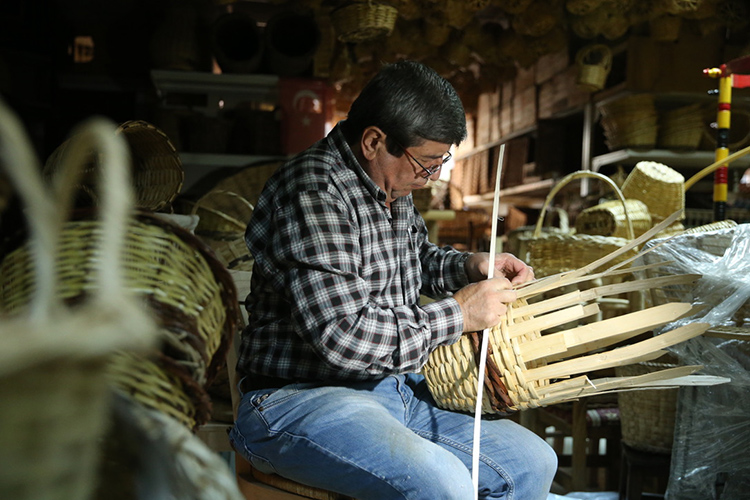The Karamürsel basket is a traditional handmade carrying tool produced in the Karamürsel district of Kocaeli Province. Considered a part of the basketry craft, this item is made by weaving willow branches using a special technique. The Karamürsel basket is known for its durability and long-lasting use, as it is woven as a single piece, including the handle. It has traditionally been used for transporting agricultural products and carrying goods in marketplaces.
Karamürsel Basket (TRT Belgesel)
Construction Features
The basket is primarily made using branches of willow or other flexible woody plants that typically grow near water sources. The branches are first stripped of their bark and softened, then the weaving process begins. The basket is woven in a spiral form, starting from the base and working upward. No fastening materials such as nails or screws are used during this process. Since the handle is woven together with the body, it provides structural strength during carrying. The average height of the basket is approximately 50–70 cm, but it can be produced in different sizes depending on its intended capacity.

Making of the Karamürsel Basket (Anadolu Ajansı)
History
The exact origins of the Karamürsel basket are not documented, but the region’s basketry tradition is known to date back to the Ottoman Empire. Karamürsel’s geographical location—on the coast of the Sea of Marmara—and the abundance of natural willow resources in the surrounding area contributed to the development of this craft. Throughout the 19th century, the local population produced these baskets as a means of livelihood and integrated them into the local market economy.
Production of the Karamürsel basket continued into the Republican era and remained widespread in both rural and urban settings until the mid-20th century. However, the increasing use of plastic and synthetic materials led to a decline in traditional basket-making. Today, the craft is sustained by a small number of artisans and is recognized as part of the intangible cultural heritage.
The Phrase "Karamürsel Basket"
Meaning and Usage
In Turkish, the phrase “Karamürsel sepeti” is used metaphorically to describe a person or object that may appear small but can hold or accomplish a great deal. A common idiomatic form is:
“Ufacık tefecik gördün, Karamürsel sepeti mi sandın?” (“You saw a tiny little thing, did you think it was a Karamürsel basket?”)
This highlights the idea that something or someone underestimated based on appearance may, in fact, contain much more than expected.
Historical and Social Background
The phrase originates directly from the structural features of the Karamürsel basket. Although it may not appear large from the outside, the basket has a surprisingly spacious interior. This physical trait inspired the use of the object as a metaphor in everyday speech, eventually becoming a set idiom.
Though it is not known precisely when the phrase became widespread, it is believed to have taken hold in the late 19th or early 20th century, during the period when these baskets were commonly used in Anatolian marketplaces and for transport. Especially in rural culture, the phrase has served as a proverbial reminder not to underestimate people or things based on appearance.
Folk Tale
There are several folk tales associated with the phrase “Karamürsel sepeti”. One widely shared story tells of an elderly woman at a village market who surprises onlookers by pulling numerous goods out of her seemingly small basket. Another version links the expression to the Ottoman palace.
According to this tale, one of the Ottoman sultans stopped near Karamürsel during a hunting trip. A local boy approached him carrying a very small-looking basket. The sultan mockingly asked, “What could you possibly be carrying in that tiny basket, boy?” In response, the boy reached into the basket and pulled out olives, bread, cheese, some fruit, and even a small chicken. Amazed, the sultan remarked on the basket’s capacity. The boy replied, “This is a Karamürsel basket, sir—it holds more than you’d think.”
Impressed by the witty answer, the sultan had the basket taken to the palace for artisans to study. From then on, the phrase “Karamürsel sepeti” began to be used not only to describe a physical object but also to metaphorically represent people or things that appear unassuming but are capable of much more. While this story is not confirmed by historical records, it provides a cultural narrative that explains the idiom’s enduring usage.

